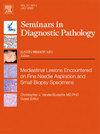An update on mixed phenotype acute leukemia
IF 3.5
3区 医学
Q2 MEDICAL LABORATORY TECHNOLOGY
引用次数: 0
Abstract
Mixed phenotype acute leukemias (MPALs) are a heterogeneous group of acute leukemias that show differentiation along more than one lineage. MPAL are rare and account for <5 % of all acute leukemias and demonstrate an inferior prognosis compared with standard acute lymphoblastic or myeloid leukemias. Historically, due to the limited understanding of its underlying pathogenesis, there were no well-established classification schemes, leading to difficulty in both diagnosis and treatment. With the advent of new nomenclature and algorithms, including the European Group for the Immunological Characterization of Leukemias (EGIL) scoring system, World Health Organization (WHO) tumor classification, and International Consensus Classification (ICC), these entities are better defined and there have been significant changes in clinical management. Additionally, an increasing variety of molecular and cytogenetic abnormalities have been recognized, which have improved the diagnostic classifications and may represent important potential therapeutic targets. However, due to its rarity, current evidence and recommendations on the clinical approach to MPAL are largely based on retrospective studies with relatively small cohorts, and it remains a diagnostic and therapeutic dilemma. In this review, we discuss the most updated classifications, genomic complexity, and diagnostic and therapeutic strategies for MPAL.
混合表型急性白血病的最新进展。
混合表型急性白血病(MPALs)是一种异质组急性白血病,显示分化沿着一个以上的谱系。MPAL是罕见的,而且是有原因的
本文章由计算机程序翻译,如有差异,请以英文原文为准。
求助全文
约1分钟内获得全文
求助全文
来源期刊
CiteScore
4.80
自引率
0.00%
发文量
69
审稿时长
71 days
期刊介绍:
Each issue of Seminars in Diagnostic Pathology offers current, authoritative reviews of topics in diagnostic anatomic pathology. The Seminars is of interest to pathologists, clinical investigators and physicians in practice.

 求助内容:
求助内容: 应助结果提醒方式:
应助结果提醒方式:


